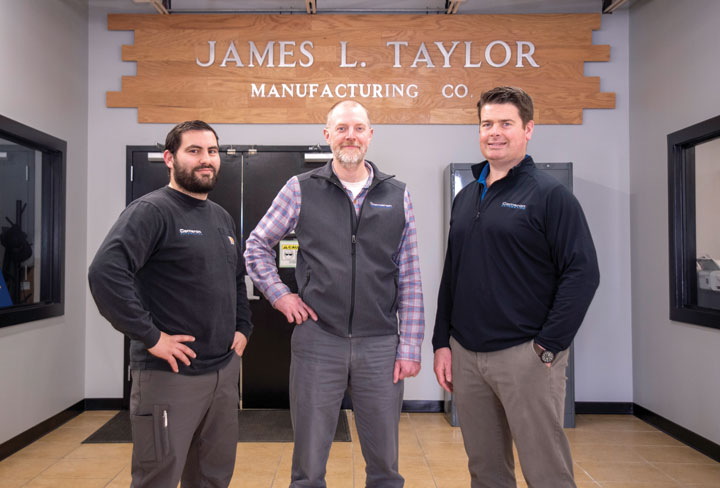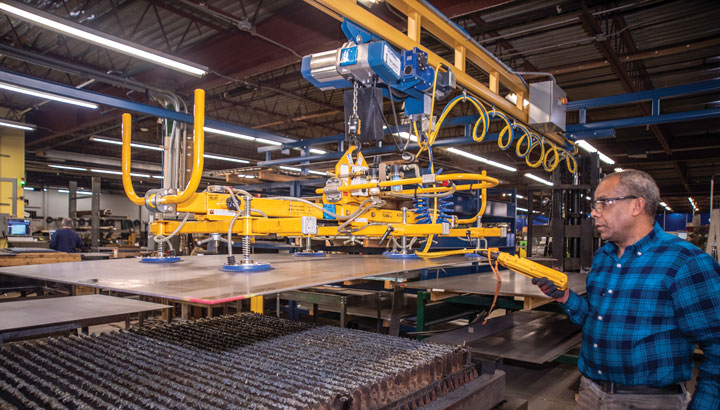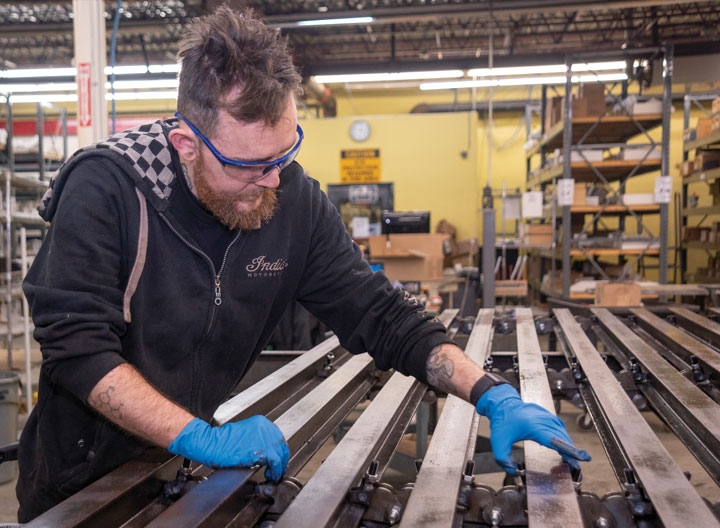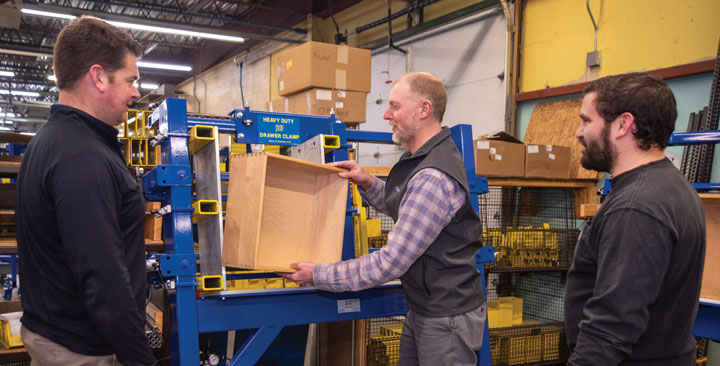More than a Century of Quality and Customer Focused Innovation in Poughkeepsie

The Council of Industry has been supporting manufacturing firms in the Hudson Valley since 1910. That is 114 years. For 113 of those years, Poughkeepsie-based James L. Taylor Manufacturing has been a member of our association.
Its 43 employees design and manufacture equipment for the woodworking industry. From simple clamp, gluing and laminating machines to highly automated chop and vision scanning systems, James L. Taylor’s products set the standard for the industry and are used by furniture and cabinet makers across the globe. In many ways, in fact, James L. Taylor typifies Hudson Valley manufacturing – innovative, creative, global, high tech in both products and process, and — perhaps most important, resilient.
The Industry
To best understand the company today it is important to know its founding and evolution. It is also necessary to understand the key role glue plays in the manufacture of furniture, cabinets, doors and other wood products. Any time you want two pieces of wood to join together glue is necessary. A quality wood table-top, for example, is not made from a single plank of wood but from several joined together. The planks are selected for their quality, cut to size and joined together using a variety of techniques – all of which require clamping and gluing. Different glues require different curing times.
James L. Taylor makes the equipment woodworkers use to complete this process. The company makes machines that are used in small woodworking shops as well as machines used in high volume cabinet, furniture and flooring operations. While clamping and gluing machines are the core of the company’s products, they have, through the years, branched out to make equipment that assists in other parts of the process, including vision systems and rip systems to maximize board yield.

More Than a Century of Innovation
In 1911 James L. Taylor established the James L. Taylor Manufacturing Company in a small factory building on Parker Avenue in the City of Poughkeepsie. There, the company produced his quick-adjusting, self-locking bar clamp. This patented clamp was a significant step forward in the edge gluing of lumber and was a commercial success.
In the 1920s, in response to technological advances in adhesives, the company developed and patented “The Taylor” revolving clamp carrier. This innovative machine was a major first step toward mass production in the U.S. furniture industry.
In 1940 Taylor engineers developed the Panel Flo, a continuous feed edge gluing machine. From the very beginning, the Panel Flo was acclaimed as the answer to mass production gluing. In 1950 Taylor introduced the Panel Mint, a batch type semiautomatic edge gluer which filled a manufacturing need in the industry between the Clamp Carrier and the fully automated Panel Flo.
During the 1950s and 1960s, Taylor designed new accessories to complement the Panel Flo and Panel Mint that helped customers improve efficiency and cut costs. These included the Conveyorized Glue Applicator, Mix-Mizer and Automatic Cut Off Saw. Also, in the 1960s, Taylor revived the Clamp Carrier from the 1920s. Revamping its design with the introduction of the pneumatic Clamp Tightener and Panel Flattener.
During the 1970s, the Taylor Panel-Mint was the machine of choice. This Steam-Heated Batch Press matched with low-cost urea resin glue. The well-designed machine was used by many furniture manufacturers to produce hardwood and softwood panels.
Midway through the 1980s, Taylor designed and produced the first automated clamp carrier. This changed the direction of the clamp carrier line and made it the industry standard for edge gluing machines. The company introduced increasingly advanced automated products throughout the 1990s and 2000s, including rip systems, vision scanning systems, panel layup and color matching machines.
Taylor Manufacturing remained at the Parker Avenue factory until August of 2014. Through the years that building had been expanded and updated to accommodate the new technologies and product lines necessary to provide their customers with quality machines. Eventually, however, the company needed more room to expand and improve their manufacturing processes and in 2014 they relocated just a few miles away to Salt Point Turnpike in the Town of Poughkeepsie.

One Company, Three Product Lines
Today the Salt Point Turnpike facility is home to the company’s three product lines – JLT Clamps, Taylor Products and Cameron Automation.
JLT Clamps is a world leader in door and panel clamping machinery for small and large custom woodworking shops. These products include: face frame tables, stile and rails squaring clamps, miter squaring clamps, entry door clamps and drawer clamps.
The Taylor Products line is the Industry Leader in room temperature gluing and laminating equipment. Products in this line include clamp carriers for panels, doors, furniture components, flooring, molding blanks, and more. Clamp carriers are machines that enable multiple panels to be assembled at one time using room temperature gluing without giving up valuable shop floor space. Room temperature gluing is the most forgiving and versatile way to glue up panels, treads, molding blanks, furniture components, flooring, railing stock, posts, and beams. Other products in the Taylor line include: conveyor systems and glue mixing, and application system.
As the name implies, the Cameron Automation line is machinery for automating and improving common rough mill processes. This line, named for former company owner and president Steele Cameron, was first introduced in 2002. The Cameron Line has helped revolutionize the woodworking industry with products that automate repetitive processes, maximize raw material yield, improve accuracy and consistency, and improve shop safety. Products in this line include: rip systems, chop optimizers, vision and scanning systems and panel layup and color matching machines.
A Focus on the Customer
How does a small manufacturer in Poughkeepsie not only last for 113 years but advance to be an industry leader? We put that question to Taylor’s leadership team of Gordon Burdis, President; Michael Burdis, CEO; Jake Greenfield Vice President of Manufacturing; and Josh Renner Vice President of Engineering. The response, almost in unison, was “We listen to the customer.”
“The woodworking Industry has always been changing and continues to change,” Gordon Burdis says. “We are able to keep up with it, hopefully stay ahead of it, by maintaining close relationships with our customers. If we know what their opportunities are, what their pain points are, what their competition is doing – then we can develop products that they want and need, that provide value.”
Indeed, customer satisfaction permeates the company culture at Taylor Manufacturing from top to bottom. (Our interview was slightly delayed while the team solved a problem for a customer.)
“From the day I started it was drilled into my head that we are going to take care of our customers. It is the focus of every employee here.” Jake Greenfield said. “I know Mr. Burdis (Michael) had a lot to do with that but I assume in goes back even further than him because ‘focus on the customer’ is ingrained into everything every employee does every day.”
That customer focus has led to strong long-term relationships with clients, which in turn has driven much of the innovation in Taylor Manufacturing’s product lines through the decades.
Greenfield offers an example. “We make a product for the flooring industry that I was heavily involved in,” he says. “The product has proven to be very successful in large part because of customer input. We have a lot of competitors in the flooring industry, but we’re the easiest to work with so they are always pitching us new ideas. Sometimes it’s a modification to one of our existing machines, sometimes it’s a request for an entirely new machine.”
Michael Burdis adds. “It happens all the time. Hardly a week goes by where one of our customers, in their efforts to improve efficiencies, hasn’t come to us with a request to make something for them.”
Vertical Integration
Key to Taylor Manufacturing’s ability to maintain strong relations with their customers and meet and exceed expectations is a decision the company made decades ago. They would control as much of their process as possible by doing all they can “in-house.” From design and engineering to sheet metal work to fabrication to powder coating to programming, Taylor employees design every machine, make nearly every part, install every component, program every controller and test and, when necessary, service every machine they sell.
“We want to be able to control the quality and the availability of all the key parts of the products we make,” Josh Renner says. “It helps us control our process and scheduling better which leads to faster turnaround for orders, better reliability and higher quality.”
It is worth noting that this integration proved advantageous during the pandemic, a time when supply chain challenges were wreaking havoc on manufacturers everywhere. With fewer suppliers to depend on the company faced fewer bottlenecks and was able to continue to deliver to its customers. “I wouldn’t say there were no disruptions,” Gordon Burdis says. “But we were able to meet demand and maintain our quality and reliability.”

A Skilled and Dependable Workforce
For a small company to keep all manufacturing processes in-house requires a skilled and versatile workforce, and the team at Taylor fits that bill. “We have a great team in place here,” Renner says. “We have a good mix of older skilled workers and younger employees. We have pretty low turnover because people really like to work here.”
“It’s challenging and rewarding, It’s a little different every day. People get to dig into their work and see the finished products shipped to customers.” Greenfield adds.
“For the right person, and we seem to have a whole lot of the ‘right people,’ this is a great place to work,” Renner says. “But it’s not for everyone. For example, we expect a lot from our engineers. We expect them to be programmers, to build machines, to talk to customers, even sometimes to go on the road and fix machines. Not everyone wants to do that, some people just want to design. But for the person who likes a variety of challenges and wants to be a part of solutions – we are a wonderful place to work.”
Key to finding the right people has been the company’s reputation and referrals from employees, suppliers, customers, or even just people in the community familiar with the company. “Nearly all of our people are recommended to us, either by a current employee, or someone who knows us well. We don’t really find them on big online job boards,” Renner says. “We don’t take that for granted though, we work to build and keep relationships with places like Dutchess Community College to keep a pipeline in place.”
“I want to add that these skilled and versatile employees, whether we’re talking engineers or folks on the floor, don’t just show up knowing everything and start cranking out work overnight. “We invest a lot of time developing people,” Gordon Burdis says. But, like Josh said, if they have the right attitude and aptitude, we are happy to spend that time and it usually pays off in a good, long-term employee.”

Cautious Optimism About the Future
The woodworking industry was a sector of the economy that grew during the pandemic as lockdowns drove home renovations that included new kitchens and furniture. James L. Taylor products were very much in demand and the company was at or near capacity for several years. In late 2023 and now in 2024 things have slowed a bit – a change that is welcomed by the leadership team.
“We are happy with the pause,” says Gordon Burdis. We welcome the chance to settle down and regroup, get ready for what we see as sustained growth going forward.”
Michael Burdis thinks the company is in a good position to be successful moving forward because it can build on its past. “I tell the young guys all the time – and they listen and agree – to be successful we have to have three things working together at the same time. We need the tried-and-true products that got us where we are. We need a ‘center section’ – the products that we recently developed that are profitable and have a life cycle of 15-25 years. And we need to always have new products in development that will be ready in 3-5 years.”
Customer feedback largely determines what the next generation equipment from James L. Taylor will be, but it is not the only factor. The company’s evolving capabilities and expertise is also a factor.
“Josh mentioned earlier a machine we developed for the flooring industry that he worked on. The customer had a need, and there was a solution out there – a competitor has a machine to do the job that costs $750,000. We developed a solution that costs a small fraction of that and does the same job. It’s a great example of us using our experience and expertise, applying some lessons learned years ago, to develop a new, lower cost solution for our customers and a profitable machine for us,” Renner says.
That is the same model of success and innovation that has worked for James L. Taylor for more than a century and is likely to carry it forward for the foreseeable future. So next time you are in your kitchen, take a look around and think about the machines used to assemble your cabinets, the table where you are sitting, the floor it rests on, or the door to the dining room. Chances are pretty good that one or more of these were made with James L. Taylor equipment, manufactured in Poughkeepsie, New York.



